Finally, finally, finally, I am getting up the recipes I learned at the cooking class I took at the restaurant Taste of India in Dharamsala. It was a really fun experience, a bit pricey ($18) but totally worth it! I learned how to cook 10 recipes from a woman in the basement of the guesthouse adjoining the restaurant, along with two middle-aged guys from Britain. We just watched and copied everything down, not participating other than making a couple samosas, but I really didn't mind. It was just so fun watching her make the recipes.
On the first day, we learned how to make Aloo Gobhi, Palak Paneer, Chapati, Dal Makhani, Yellow Dal, and Malai Kofta. I am posting all recipes but the Malai Kofta, because I really didn't think it was good at all -- much to sweet, and not really tasting like Malai Kofta to me. The others, however, were all great.
Recipes:
Aloo Gobhi
This is a really easy dish, but one of my favorites out of everything we made. It's a pretty dry curry. Serve with rice or bread, and preferably a dal.
Ingredients:
4 serving spoons (she used this spoon to measure a lot, and I think it was a little more than a tbsp, in between that and 1/4 cup) vegetable oil
1/2 tsp cumin seeds
2 tsp garlic, chopped
2 tsp fresh ginger, chopped
500 grams cauliflower, chopped (or one big head of cauliflower)
250 grams potatoes, peeled and chopped (or 4 medium potatoes)
1 green chili, chopped (optional -- we didn't use it and I really don't think it's necessary. This has tons of flavor.)
1/4 tsp turmeric powder
1/4 tsp red chili powder
1 tsp coriander powder
1 tsp salt
1/2 tsp garam masala
2 tsp fresh coriander leaves, chopped
Heat the oil well in a large frying pan. Add the cumin. When the cumin pops, add the garlic and ginger. Stir it briefly and add the vegetables and green chili (if using.) Mix and cook for 1 minute. Then add all the spices (turmeric, red chili powder, coriander powder, salt, and garam masala.) Mix well and add 1/4 cup of water. Cover and cook at a low temperature for at least 20 minutes. The vegetables should be soft. Remove from heat and stir in fresh coriander. Serve hot!
Palak Paneer
YUM. Tastes just like at the restaurant, especially with the flavor of fenugreek leaves (hard to find but worth it.) Serve with hot chapati or parantha.
500 grams spinach (or one big bunch of spinach)
2 medium red onions, finely chopped and then crushed in a blender or food processor
1 1/2 tsp ginger/garlic paste (put the same amount of each into a blender and grind to a fine paste, adding a little water if necessary.)
200 g tomato puree (Boil tomatoes for 2 minutes, remove the skin, and crush in a blender.)
4 serving spoons of vegetable oil or ghee
1/2 tsp cumin seeds
1/2 tsp coriander seeds
1/4 tsp red chili powder
1 tsp coriander powder
1 tsp salt
1/2 tsp garam masala
1 tsp fenugreek leaves (REALLY IMPORTANT. I had never before seen or heard of fenugreek leaves, only fenugreek seeds. The leaves are nothing like the seeds in flavor. They have a really distinctive taste and really add to this dish. They come in bags, dried, at any Indian market.)
200 g paneer (recipe will follow)
2 tsp cream
2 tsp butter
2 tsp fresh coriander leaves, chopped
How to make paneer:
Boil 2 liters of milk. Add 1/2 cup lemon juice, and boil for 5 more minutes. Drain the milk into a cheesecloth. Make the cheese into one big ball and squeeze out the liquid. Wrap the block in a cloth, put something very heavy on top, and let rest for at least two hours. Then, cut into cubes to use in the palak paneer.
Recipe for palak paneer:
Cut spinach roughly, wash it, and boil it for 10 minutes in 1/2 cup water. When it's done, grind it with any remaining water in a blender.
Heat the oil in a pan. When it's well-heated, add the cumin and coriander seeds. When the seeds begin to pop, add the crushed onions. Cook for 8 to 10 minutes. When the onion mixture separates oil on the corners, it is cooked. Add 1/2 cup water and ginger/garlic paste. Stir, cook for two minutes, and add the remaining spices. Cook at a low temperature for two more minutes. Add the tomato puree and cook 2-3 minutes more. When you see oil on top of the tomatoes, they are cooked. Add spinach to the sauce. Mix well, cover, and cook for 5 more minutes. Add paneer and cook 5 minutes more.
Add cream and butter at the last minute, and serve.
Chapati
Ingredients:
2 cups wheat flour (I use whole wheat and white flour mixed)
1/2 tsp salt
2 tbsp oil
1 cup water (or more or less... add a little add a time and stop once you have achieved a soft dough.)
Combine all ingredients, kneading only until they are well-mixed. Cover the dough and let rest for 30 minutes. Form the dough into golf ball-sized balls. Coat them in flour and roll them out one and a time. Heat a griddle and do not begin to cook chapati until it is very well-heated. Cook each one only about a minute (or less) on each side. They should puff up beautifully. Serve with curry!
Dal Makhani
This black dal is very popular in Punjab.
200g black lentils and 50g red kidney beans, mixed together, washed, and soaked for at least 7 hours.
2 cinnamon sticks
2 whole black cardamom pods
4 whole green cardamom pods
5 cloves
1/4 tsp red chili powder
1 tsp salt
3 tbsp oil or ghee
2 tsp fresh ginger, finely chopped
2 medium tomatoes, chopped
1/2 cup milk
2 tsp fenugreek leaves
2 tbsp fresh cream
2 tsp butter
Bring 2 1/2 liters of water to a boil. Add the dal, whole spices, red chili powder, and salt. Cover and cook for one hour, or until dal is very soft.
In a small frying pan, heat the oil or ghee. Add the fresh ginger and cook for 1-2 minutes. Then add tomatoes. Cook 2-3 more minutes, and then add to the dal, along with the milk and fenugreek leaves. Cook 2-3 more minutes, then remove from heat, add cream and butter, and serve.
Yellow dal:
Ingredients:
2 cups yellow dal, washed and soaked for at least 30 minutes.
1/4 tsp turmeric powder
1 tsp salt
3 tbsp oil or ghee
1/2 tsp cumin seeds
1/2 tsp mustard seeds
A pinch of asafoedita (hing)
2 medium onions, finely chopped
2 tsp finely-chopped garlic
2 medium tomatoes, chopped
1/4 tsp red chili powder
1/2 tsp garam masala
2 tsp fresh coriander
Bring 2 liters of water to a boil. Add dal, turmeric, and salt. Cook for 30 minutes.
In a separate pan, heat the oil or ghee well. Add the cumin seeds, mustard seeds, and asofoedita. After they begin to pop, add the chopped onion and cook 2-3 minutes more. Add the garlic, and after a minute, the tomatoes. Cook 2-3 minutes. Add the chili powder and garam masala. Add the mixture to the dal. Cook two minutes, then remove from heat, add fresh coriander, and serve.
what zoe and max eat
this blog is documenting what we eat. it's about food: growing the crops, the philosophy and ethics, the kitchen, food prep, and recipes. we also write about the culture, the methods, and anything mildly related.
Saturday, April 9, 2011
Momos
Finally, I am getting the momo recipes up! Several weeks ago, Max and I took a 2-hour cooking class at Sangye's Kitchen on how to make momos. It was a really fun experience. Sangye's kitchen was tiny, and his stove little more than what we had at our guesthouse (before the gas started leaking.) He was also really nice and helpful. He runs these classes twice a day, six days a week. Monday and Friday he teaches breads, Tuesday and Saturday noodle soups, and Sunday and Thursday momos.
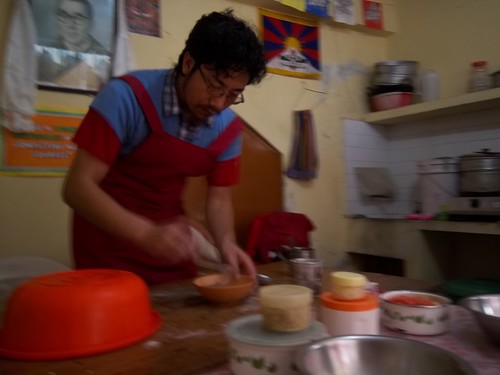
What are momos, you may ask? They are Tibetan dumplings. They are usually filled with either vegetables, potato, or meat, but in our class we made veggie, spinach and cheese, and CHOCOLATE.
How to make momos:
The recipe makes about 70 momos. Half the recipe if you are serving fewer people.
To make the dough:
Ingredients:
1/2 kg white flour
1 tsp baking powder
2 cups water
Sift flour and baking powder together in a mixing bowl. Add water slowly and squeeze dough together until well-mixed. Place on a floured surface and knead for five minutes. Cover with a wet cloth and let sit for five minutes while you prepare the fillings.
Vegetable filling:
Combine the following:
1/4 head of cabbage finely chopped
1 large carrot finely chopped
1 large onion finely chopped
50 grams uncooked glass vermicelli
1 tsp garlic finely chopped
1 tsp ginger finely chopped
1 tsp salt
1/8 tsp black pepper
4 tbsp neutral vegetable oil of your choice
Potato filling:
Combine the following:
2 large potatoes cooked, peeled, and mashed
2 tsp spring onion finely chopped
1 tsp garlic finely chopped
1 tsp ginger finely chopped
1 tsp salt
1/8 tsp black pepper
4 tbsp neutral vegetable oil
Spinach and cheese filling:
Combine the following:
1/4 of a bunch of fresh spinach finely chopped
25 grams any cheese, grated
1 onion finely chopped
1 tsp garlic finely chopped
1 tsp ginger finely chopped
1 tsp salt
1/8 tsp black pepper
4 tbsp neutral vegetable oil
Chocolate filling!
Ingredients:
4 tbsp neutral vegetable oil
2 tbsp flour
2 tbsp sesame seeds
2 tbsp sugar
About a half cup dry hot chocolate mix (Although this is an approximation -- use how much looks good to you!)
Heat the oil in a frying pan at a low temperature and add all ingredients. Cook until golden-brown, stirring constantly. Allow to cool before filling momos.
Making the momos:
Prepare water in a steamer to steam the momos.
Knead the dough a little to soften it. Make the dough into a long sausage shape. cut into lengths as wide as 1/2 a finger. Press them down into little disks. You can kind of see here:
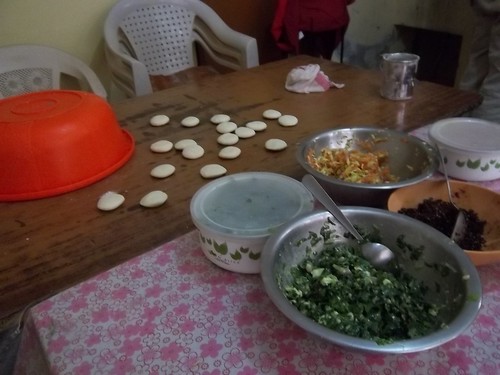
Roll each one out into a round shape. Now you are ready to form the momos. We learned how to make three momo shapes:
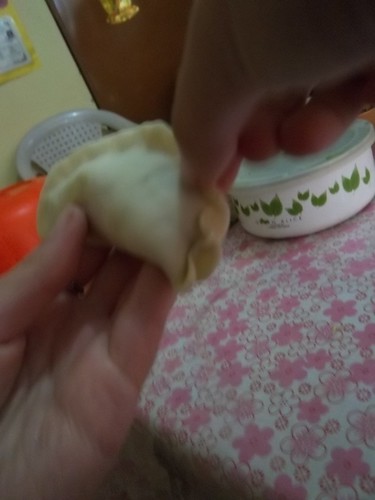
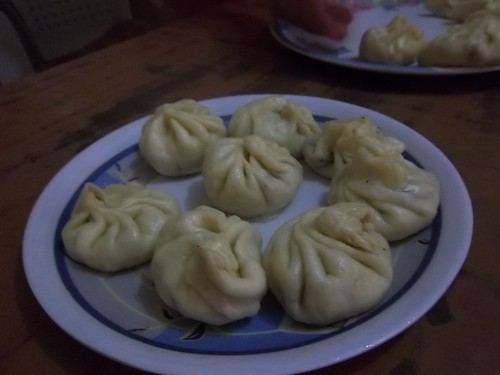
You can kind of see all three here:
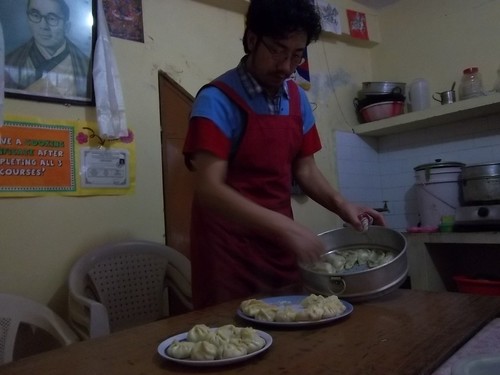
The easiest way is to just put a scoop of filling in the center of each one and seal the edges with water. You could also try imitating the photos -- I remember the rolled edge was quite easy, but I have no memory of exactly how to do it!
Place prepared momos in the top of the steamer and steam for 15 minutes. They should feel pretty dry when done, rather than sticky. Serve hot with soy sauce and chili sauce! (Except the chocolate; that would be weird.)

What are momos, you may ask? They are Tibetan dumplings. They are usually filled with either vegetables, potato, or meat, but in our class we made veggie, spinach and cheese, and CHOCOLATE.
How to make momos:
The recipe makes about 70 momos. Half the recipe if you are serving fewer people.
To make the dough:
Ingredients:
1/2 kg white flour
1 tsp baking powder
2 cups water
Sift flour and baking powder together in a mixing bowl. Add water slowly and squeeze dough together until well-mixed. Place on a floured surface and knead for five minutes. Cover with a wet cloth and let sit for five minutes while you prepare the fillings.
Vegetable filling:
Combine the following:
1/4 head of cabbage finely chopped
1 large carrot finely chopped
1 large onion finely chopped
50 grams uncooked glass vermicelli
1 tsp garlic finely chopped
1 tsp ginger finely chopped
1 tsp salt
1/8 tsp black pepper
4 tbsp neutral vegetable oil of your choice
Potato filling:
Combine the following:
2 large potatoes cooked, peeled, and mashed
2 tsp spring onion finely chopped
1 tsp garlic finely chopped
1 tsp ginger finely chopped
1 tsp salt
1/8 tsp black pepper
4 tbsp neutral vegetable oil
Spinach and cheese filling:
Combine the following:
1/4 of a bunch of fresh spinach finely chopped
25 grams any cheese, grated
1 onion finely chopped
1 tsp garlic finely chopped
1 tsp ginger finely chopped
1 tsp salt
1/8 tsp black pepper
4 tbsp neutral vegetable oil
Chocolate filling!
Ingredients:
4 tbsp neutral vegetable oil
2 tbsp flour
2 tbsp sesame seeds
2 tbsp sugar
About a half cup dry hot chocolate mix (Although this is an approximation -- use how much looks good to you!)
Heat the oil in a frying pan at a low temperature and add all ingredients. Cook until golden-brown, stirring constantly. Allow to cool before filling momos.
Making the momos:
Prepare water in a steamer to steam the momos.
Knead the dough a little to soften it. Make the dough into a long sausage shape. cut into lengths as wide as 1/2 a finger. Press them down into little disks. You can kind of see here:

Roll each one out into a round shape. Now you are ready to form the momos. We learned how to make three momo shapes:


You can kind of see all three here:

The easiest way is to just put a scoop of filling in the center of each one and seal the edges with water. You could also try imitating the photos -- I remember the rolled edge was quite easy, but I have no memory of exactly how to do it!
Place prepared momos in the top of the steamer and steam for 15 minutes. They should feel pretty dry when done, rather than sticky. Serve hot with soy sauce and chili sauce! (Except the chocolate; that would be weird.)
Sunday, April 3, 2011
more recipes coming
hey, sorry for the big gap. next week zoe is taking a two day indian cooking class where she will learning something like 10 recipes. also we will get the momo recipe up soon too, because momos are awesome.
Sunday, March 6, 2011
coconut fun
i will let it remain in mystery of how we opened it for now.... bring me a coconut and i will show you how!
Saturday, February 26, 2011
Dal and Cabbage Curry
Meanwhile, in Cambridge, Massachusetts, USA, Mana and Pop cooked Max and Zoë's recipes for dal and cabbage curry. They were delicious. I'm pretty sure they followed the official Indian instructions almost to the letter. Pop made the dal (I think he said he used a slightly different kind of dal?), and Mana made the cabbage, using a bit less coconut than Zoë specified. She wondered if it would come out differently because she wasn't using fresh coconut right from the shell. Here are several pictures of Isaac enjoying our meal:


meat ethics in india
it is common belief that cows are not consumed in india. i arrived in this country thinking that but found out otherwise. we had a discussion with a local about meat consumption in india. in the cast system brahmans are the only ones required to be vegetarian. it is quite common that the poor consume meat.
back in the day when it was illegal to eat cows the poor farmers or peasants would pay off the police men to eat beef in peace. considering the farmers'/peasants' situations it is quite ethical to consume the cow in a country with such high malnutrition.
also back in the day, at birth often the female calves were killed or consumed at a very young age. the bulls were valued a lot for their ability to do work in the field. now it has become the opposite, the bulls are needed less because of cheap fossil fuels and the females are valued because of the high milk demand. i believe you would find a similar pattern in the united states.
i have yet to see beef on the menu, but you never know. as we venture further north i think we will see more meat on the menu. alexis, a fellow traveler, told us about going to remote villages and the families making her a meal of chicken broth or sauce and these black balls. she was informed by the villagers these black balls were almost completely fiber and were to be soaked in the chicken sauce. she said you couldn't chew them because they would immediately fuse to your teeth.
considering the village was probably half starving she said she could not turn the meal away without being offensive. furthermore, she had to finish the meal as to not be rude and recognize the importance and value of food to those people.
i expect we may run across this situation. despite being vegetarian, i am prepared to eat whatever is offered as long as it's cooked well. i really cannot imagine doing anything else. it is difficult playing with food ethics on such a large scale.
i had a discussion about vegetarianism and ethics with a local man. he had quite a global view, the line he said that has stuck with me the most is: "how can you argue about fertilized and non-fertilized eggs when so many people are hungry? the majority of people eat what they can."
it was a difficult discussion and made my gut turn. it was a shot directly to the heart of my food ethics. he made veganism, the diet i consider most ethical, seem wrong. the fact is that vegans cannot eat entirely local, at least not in maine, without becoming deficient in something. he is right, choice is luxury, but his view was so completely global, a dog-eat-dog view.
i consider local the best and most responsible when teamed up with veganism. obviously these two cannot work together completely, but my buddhist perspective kicks in that i am not greater than a cow, and feel nothing different from a cow or any other creature.
i did not mention it to him, but he did talk about how i could either treat local animals really badly by eating them or treat some humans really badly exploiting them overseas for some stupid exotic fruit.
the day the dog killed the monkey i tried to explain to one of the people involved in the incident (10-year-old Milan) the monkey probably had a heart attack. he looked at me, confused, and said, "monkey has a heart?" india in general seems a bit more distant from animals, especially in dog treatment, compared to the states.
as for conclusion about my current food ethics since that chat, i still prefer vegan/local with some mindful cheating, and for now vegetarianism while i travel. what makes me feel awful about it is i know i am picking the lesser of the two evils, neither is really that close to perfect or fossil fuel-free. it would take the commitment of really going back to the land and networking within a few miles to get relatively close.
Tuesday, February 22, 2011
kitchen equipment
I thought you might appreciate a bit of a description of the kitchen at the farm, so that you have an idea of what we were working with when we made all these recipes! Max said: "At first I was afraid of it, but then I realized it's the most awesome kitchen ever." This sums it up pretty well. It's basic, but it has everything you need to make delicious food -- in many ways, it's more well-stocked than my kitchen at home.
The highlight of the kitchen is definitely the grinder. It came with the house (they had to pay a couple thousand rupees extra) and Max estimates that it weighs about 500 lbs. That may be a slight exaggeration, but you get the idea. Here I am (a little blurry) grinding masala paste:
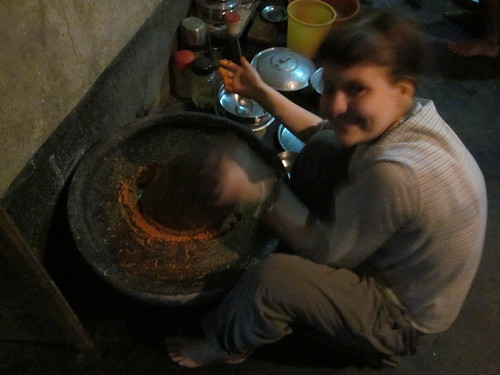
The stove in the kitchen is simply an open fire with three holes on top for heavy metal pans. Max making pancakes over the fire:
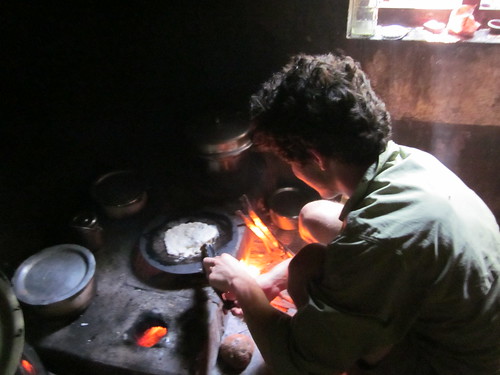
Health risks aside, it is a very effective stove, and pleasantly warm in the morning when we manage to get up at six or seven to help make breakfast.
Vegetables are kept in a corner that's shady throughout the day. See the coconuts in the back?
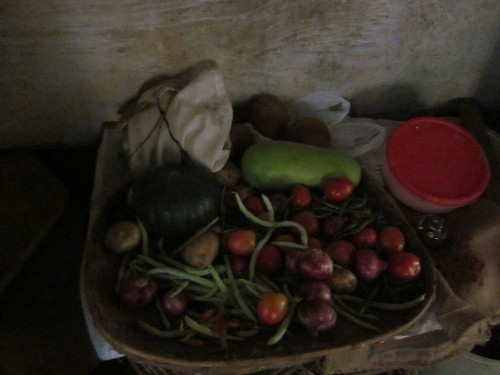
Bananas hang from the ceiling.
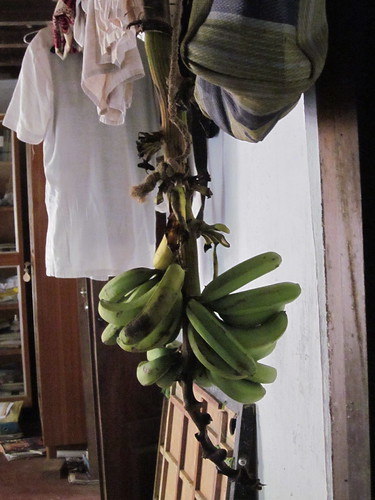
Water is kept in this large silver container.
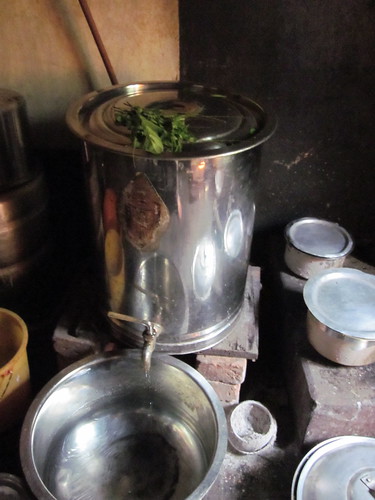
Curry leaves are kept on top of the water container. When I asked what they were, no one knew the name in English. Ranjana told me, "You find these leaves in all Indian cooking, I think." For a while I couldn't figure it out, and I thought maybe they were something I'd never heard of before. Then I figured it out: curry leaves! Of course! They have a nice smell and nice mild (but distinct) flavor. Y'all can get them at the Indian market in South Portland.
Various spices, sugars, and condiments.
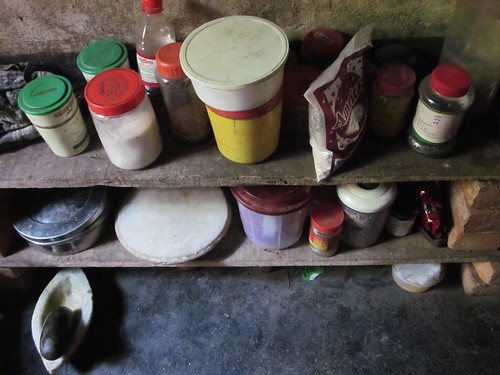
Plates, cups, bowls, and minimal silverware (i.e. three spoons) -- all made of metal.
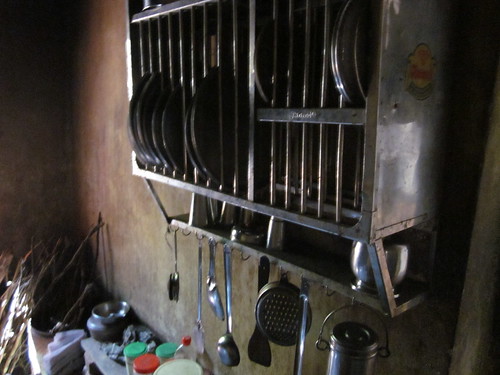
Various covered pots and pans full of leftovers sit here throughout the day. Most are eaten with meals or as snacks. The rest go to Gunda, the neighbor's dog.
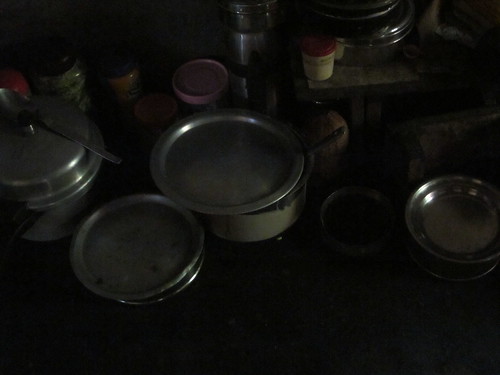
I really appreciate this kitchen and had lots of fun here cooking with Ranjana and Max. Also, my ability to grind masala improved significantly, and hopefully the strength of my left arm as well! I'll miss the farm kitchen for sure.
The highlight of the kitchen is definitely the grinder. It came with the house (they had to pay a couple thousand rupees extra) and Max estimates that it weighs about 500 lbs. That may be a slight exaggeration, but you get the idea. Here I am (a little blurry) grinding masala paste:

The stove in the kitchen is simply an open fire with three holes on top for heavy metal pans. Max making pancakes over the fire:

Health risks aside, it is a very effective stove, and pleasantly warm in the morning when we manage to get up at six or seven to help make breakfast.
Vegetables are kept in a corner that's shady throughout the day. See the coconuts in the back?

Bananas hang from the ceiling.

Water is kept in this large silver container.

Curry leaves are kept on top of the water container. When I asked what they were, no one knew the name in English. Ranjana told me, "You find these leaves in all Indian cooking, I think." For a while I couldn't figure it out, and I thought maybe they were something I'd never heard of before. Then I figured it out: curry leaves! Of course! They have a nice smell and nice mild (but distinct) flavor. Y'all can get them at the Indian market in South Portland.
Various spices, sugars, and condiments.

Plates, cups, bowls, and minimal silverware (i.e. three spoons) -- all made of metal.

Various covered pots and pans full of leftovers sit here throughout the day. Most are eaten with meals or as snacks. The rest go to Gunda, the neighbor's dog.

I really appreciate this kitchen and had lots of fun here cooking with Ranjana and Max. Also, my ability to grind masala improved significantly, and hopefully the strength of my left arm as well! I'll miss the farm kitchen for sure.
Subscribe to:
Posts (Atom)

